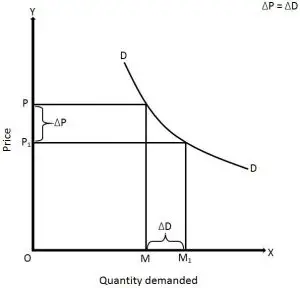Elasticity of demand refers to price elasticity of demand. It is the degree of responsiveness of quantity demanded of a commodity due to change in price, other things remaining the same.
Mathematical Expression of Price Elasticity of Demand
The price elasticity of demand is defined as the percentage change in quantity demanded due to certain percentage change in price.

Where, EP= Price elasticity of demand
q= Original quantity demanded
∆q = Change in quantity demanded
p= Original price
∆p = Change in price
Calculation of Price Elasticity of Demand
Suppose that price of a commodity falls down from Rs.10 to Rs.9 per unit and due to this, quantity demanded of the commodity increased from 100 units to 120 units. What is the price elasticity of demand?
Give that,
p= initial price= Rs.10
q= initial quantity demanded= 100 units
∆p=change in price=Rs. (10-9) = Rs.1
∆q=change in quantity demanded= (120-100) units = 20 units
Now,

The quantity demanded increases by 2% due to fall in price by Rs.1.
[Related Reading: Law of Demand]
Types or degrees of price elasticity of demand
There are 5 types of elasticity of demand:
1. Perfectly Elastic Demand (EP = ∞)
The demand is said to be perfectly elastic if the quantity demanded increases infinitely (or by unlimited quantity) with a small fall in price or quantity demanded falls to zero with a small rise in price. Thus, it is also known as infinite elasticity. It does not have practical importance as it is rarely found in real life.

In the given figure, price and quantity demanded are measured along the Y-axis and X-axis respectively. The demand curve DD is a horizontal straight line parallel to the X-axis. It shows that negligible change in price causes infinite fall or rise in quantity demanded.
2. Perfectly Inelastic Demand (EP = 0)
The demand is said to be perfectly inelastic if the demand remains constant whatever may be the price (i.e. price may rise or fall). Thus it is also called zero elasticity. It also does not have practical importance as it is rarely found in real life.

In the given figure, price and quantity demanded are measured along the Y-axis and X-axis respectively. The demand curve DD is a vertical straight line parallel to the Y-axis. It shows that the demand remains constant whatever may be the change in price. For example: even after the increase in price from OP to OP2 and fall in price from OP to OP1, the quantity demanded remains at OM.
3. Relatively Elastic Demand (EP> 1)
The demand is said to be relatively elastic if the percentage change in demand is greater than the percentage change in price i.e. if there is a greater change in demand there is a small change in price. It is also called highly elastic demand or simply elastic demand. For example:
If the price falls by 5% and the demand rises by more than 5% (say 10%), then it is a case of elastic demand. The demand for luxurious goods such as car, television, furniture, etc. is considered to be elastic.

In the given figure, price and quantity demanded are measured along the Y-axis and X-axis respectively. The demand curve DD is more flat, which shows that the demand is elastic. The small fall in price from OP to OP1 has led to greater increase in demand from OM to OM1. Likewise, demand decrease more with small increase in price.
4. Relatively Inelastic Demand (Ep< 1 )
The demand is said to be relatively inelastic if the percentage change in quantity demanded is less than the percentage change in price i.e. if there is a small change in demand with a greater change in price. It is also called less elastic or simply inelastic demand.
For example: when the price falls by 10% and the demand rises by less than 10% (say 5%), then it is the case of inelastic demand. The demand for goods of daily consumption such as rice, salt, kerosene, etc. is said to be inelastic.

In the given figure, price and quantity demanded are measured along the Y-axis and X-axis respectively. The demand curve DD is steeper, which shows that the demand is less elastic.The greater fall in price from OP to OP1 has led to small increase in demand from OM to OM1. Likewise, greater increase in price leads to small fall in demand.
5. Unitary Elastic Demand ( Ep = 1)
The demand is said to be unitary elastic if the percentage change in quantity demanded is equal to the percentage change in price. It is also called unitary elasticity. In such type of demand, 1% change in price leads to exactly 1% change in quantity demanded. This type of demand is an imaginary one as it is rarely applicable in our practical life.

In the given figure, price and quantity demanded are measured along Y-axis and X-axis respectively. The demand curve DD is a rectangular hyperbola, which shows that the demand is unitary elastic. The fall in price from OP to OP1 has caused equal proportionate increase in demand from OM to OM1. Likewise, when price increases, the demand decreases in the same proportion.
[Related Reading: Uses of Price Elasticity of Demand in Business Decision Making]
